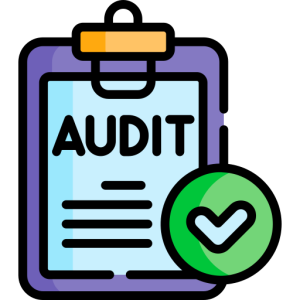As cyber threats continue to evolve, organizations must proactively protect their digital assets. A network security audit is a critical process that helps businesses assess vulnerabilities, enforce security policies, and maintain compliance with industry standards. With increasing data breaches and cyberattacks, regularly conducting a security audit is essential to safeguarding sensitive information and ensuring network integrity.
In this guide, Creative Networks explores What is Network Security Audit , Why it’s Essential, and provide a Step-by-Step Network Security Audit Checklist to help your organisation strengthen its cybersecurity posture.

What is a Network Security Audit?
A Network Security Audit is a systematic evaluation of an organisation’s IT infrastructure, security controls, and policies to identify weaknesses and assess overall security posture. This audit examines Hardware, Software, access controls, compliance adherence, and incident response capabilities to ensure the organisation is well-protected against cyber threats.
Unlike a Vulnerability Assessment, which scans for security gaps, a Network Security Audit takes a holistic approach—evaluating policies, procedures, and configurations to uncover potential risks before they become threats.
Why is a Network Security Audit Important?
Conducting regular network security audits is crucial for several reasons:
- Identifying Vulnerabilities: Audits help uncover weaknesses in the network that could be exploited by cybercriminals.
- Ensuring Compliance: They verify adherence to industry standards and regulatory requirements like ISO 27001, GDPR, HIPAA, and PCI-DSS to avoid legal penalties, which is essential for avoiding legal penalties.
- Protecting Sensitive Data: By identifying and addressing security gaps, audits safeguard critical assets such as data, systems, and devices.
- Enhancing Overall Security Posture: Regular audits lead to continuous improvement in security measures, reducing the risk of breaches.
Organisations that neglect Regular Security Audits risk becoming easy targets for cybercriminals, leading to costly security breaches and data theft.
Network Security Audit Checklist
A thorough Network Security Audit follows a structured process. Below is a comprehensive checklist to help organizations conduct an effective audit.
A successful network security audit follows a structured methodology to ensure all critical areas of IT security are assessed and secured.
1. Define the Scope and Objectives of the Audit
- Identify which hardware, software, and networks will be assessed.
- Determine key compliance requirements (e.g., GDPR, HIPAA, PCI-DSS).
- Establish goals such as identifying vulnerabilities, improving incident response, and strengthening access controls.
2. Conduct an Asset Inventory
Understanding the full scope of IT assets is crucial for identifying risks. Maintain an up-to-date list of:
- Hardware: Routers, firewalls, servers, laptops, mobile devices, IoT endpoints.
- Software: Operating systems, security applications, cloud platforms, third-party integrations.
- Network Components: VLANs, cloud environments, VPNs, and virtual machines.
A well-documented asset inventory ensures visibility and prevents unauthorized devices from accessing the network.
3. Review Access Controls and Authentication Policies
- Verify Role-Based Access Control (RBAC): Ensure employees have access only to the data necessary for their roles.
- Enforce Multi-Factor Authentication (MFA): Adding extra authentication layers minimizes unauthorized access risks.
- Review User Privileges: Remove or limit unused or excessive privileges that could lead to insider threats.
4. Assess Firewall and Intrusion Detection Systems (IDS/IPS)
- Review firewall configurations to ensure proper filtering of incoming and outgoing traffic.
- Evaluate intrusion detection/prevention systems to detect and respond to malicious activities in real-time.
- Test network segmentation to restrict access between critical and non-critical systems.
5. Conduct Vulnerability Scanning and Penetration Testing
- Run automated vulnerability scans using tools like Nessus, Qualys, or OpenVAS.
- Perform penetration testing to simulate real-world attacks and assess exploitable weaknesses.
- Analyze previous security incidents to identify recurring threats and vulnerabilities.
6. Verify Network Encryption and Data Protection
- Ensure end-to-end encryption for sensitive data transmission (e.g., SSL/TLS, VPNs).
- Check full-disk encryption on workstations, laptops, and external storage devices.
- Review backup security measures to prevent ransomware from compromising data integrity.
7. Monitor Network Traffic and Log Activity
- Deploy Security Information and Event Management (SIEM) systems to detect anomalies.
- Set up automated alerts for unusual login attempts, unauthorized access, and data transfers.
- Review security logs regularly to identify patterns indicating possible breaches.
8. Assess Compliance with Industry Regulations
Businesses handling sensitive customer data must comply with global security standards:
- GDPR (General Data Protection Regulation) – For businesses handling EU citizen data.
- HIPAA (Health Insurance Portability and Accountability Act) – For healthcare organizations.
- PCI-DSS (Payment Card Industry Data Security Standard) – For businesses processing credit card transactions.
- ISO 27001 – For organizations implementing industry-best information security practices.
9. Conduct Employee Security Awareness Training
Human error remains one of the biggest security risks. Ensure employees:
- Recognize phishing emails and social engineering tactics.
- Use strong, unique passwords and password managers.
- Follow best practices for handling sensitive company data.
Regular training reduces the risk of insider threats and accidental breaches.
10. Test Incident Response and Disaster Recovery Plans
- Verify incident response readiness by conducting mock cyberattack simulations.
- Evaluate disaster recovery plans to ensure business continuity after a ransomware attack or data breach.
- Review backup storage and recovery time objectives (RTOs) to minimize operational disruptions.
11. Document Findings and Implement Improvements
Once the audit is complete, document all vulnerabilities, risks, and compliance issues, then create an action plan to address weaknesses.
Regular security audits should be conducted quarterly or biannually to ensure ongoing protection against emerging threats.

The Consequences of Skipping Network Security Audits
Failing to perform routine security audits exposes businesses to:
- Data breaches – Cybercriminals exploit weak points, leading to stolen customer data and financial loss.
- Regulatory fines – Non-compliance with security standards can result in heavy legal penalties.
- Downtime and operational disruptions – Ransomware attacks can cripple business operations for days or weeks.
- Reputation damage – A security breach can erode customer trust and damage brand credibility.
- Proactive auditing helps prevent these risks and ensures business continuity.
Contact Creative Networks Today
Cyber threats are constantly evolving, and staying ahead requires a proactive approach. At Creative Networks, we specialise in comprehensive Network Security Audits, helping businesses identify vulnerabilities, strengthen defenses, and ensure compliance with industry regulations.
Our tailored Cybersecurity Solutions safeguard your critical data, minimise risks, and keep your operations running smoothly.
Contact Creative Networks today to secure your business and build a resilient IT infrastructure.




